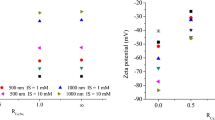Abstract
The phenomenon of isothermal supersaturation of solutions in a porous medium at ion exchange is studied on the basis of mathematical modeling. The phenomenon lies in the fact that the solution with concentration higher than the maximal solubility of the substance is formed in the pores of sorbent and no precipitation occurs. The question of why there is no precipitation in large pores or grain cracks is explored in this article. It is shown that the phenomenon under consideration can be explained not by changing of the thermodynamic conditions in the sorbent pores but by the effect of dynamic equilibrium between the aggregation of particles of the condensed phase in the inner part of the pores and their disintegration near the surface of the sorbent grains. The hypothesis proposed is verified by the quantitative studies based on simulation using the available experimental data.



Similar content being viewed by others
Abbreviations
- C ion :
-
The ion concentration in solution (mol/L)
- q :
-
The electron charge (C)
- z :
-
The ion valence (dimensionless)
- φ :
-
The local value of the potential (v)
- ϑ :
-
The porosity of the sorbent layer (dimensionless)
- \( u = \frac{\varphi qz}{kT} \) :
-
The normalized local potential (dimensionless)
- h :
-
The average thickness of the solution layer near the sorbent surface (m)
- u 0 :
-
The potential on the surface of the particle (dimensionless)
- σ :
-
The surface density of charges on the sorbent (C/m2)
- \( {\ae }^{2} = \frac{8\pi }{\varepsilon }\frac{{q^{2} z^{2} CN}}{{kT \cdot 10^{3} }} \) :
-
The constant (m−2)
- \( l = {\raise0.7ex\hbox{$1$} \!\mathord{\left/ {\vphantom {1 {\ae }}}\right.\kern-0pt} \!\lower0.7ex\hbox{${\ae }$}} \) :
-
The thickness of the “adjacent” layer near the surface of the sorbent (m)
- A :
-
The Hamaker constant (J)
- \( U_{attract} \) :
-
The potential of the attractive forces between the particles (v)
- \( U_{repell} (r) \) :
-
The potential of the electrostatic forces repelling the particles (v)
- \( U(r) = U_{repell} - U_{attract} \) :
-
the interaction potential between two particles (v)
- U max :
-
The maximal value of U (v)
- ρ:
-
The radius of a particle (m)
- r 0 :
-
The distance between centers of particles, where U (r) has a minimum (m)
- n m :
-
The number of aggregates of order m per unit volume of solution (m−3)
- \( \overline{n} \) :
-
The maximum of n(x) on the segment 0 ≤ x ≤ h (m−3)
- K :
-
The coefficient in the expression for the frequency of aggregates formation (m3/c)
- D :
-
The effective diffusion coefficient (m2/c)
- \( t_{1/2} \) :
-
The time in which the number of aggregates decreases twice (c)
- \( \beta = \sqrt {\frac{K}{D}\frac{{h^{2} }}{2}\sum\limits_{i = 1}^{\infty } {n_{i} } } ,\;\gamma = 2\beta \) :
-
The coefficients (dimensionless)
References
G. Klein, S. Cherney, E.L. Ruddick, T. Vermeulen, Desalination 4, 158–166 (1968)
D.N. Muraviev, Zh. Fiz. Khim. 53, 438–442 (1979)
D.N. Muraviev, V.I. Gorshkov, Zh. Fiz. Khim. 56, 1560–1562 (1982)
D.N. Muraviev, R.K.H. Khamizov, N.A. Tikhonov, A.N. Krachak, T.I. Zhiguleva, O.V. Fokina, Ind. Eng. Chem. Res. 37(5), 1950–1955 (1998)
D. Muraviev, R. Khamizov, N.A. Tikhonov, Langmuir 19, 10852–10956 (2003)
F. Mijangos, M. Kamel, G. Lesmes, D. Muraviev, React. Funct. Polym. 60, 151–161 (2004)
M.D. Imtiaj Ali, P.A. Schneider, Chem. Eng. Sci. 61(12), 3951–3961 (2006)
M. Ortueta, A. Celaya, F. Mijangos, D. Muraviev, Solvent Extr. Ion Exch. 26(4), 405–419 (2008)
M. Ortueta, A. Celaya, F. Mijangos, D. Muraviev, Solvent Extr. Ion Exch. (2014). https://doi.org/10.1080/07366299.2014.951283
R.K.H. Khamizov, N.A. Tikhonov, A.N. Krachak, A.N. Gruzdeva, N.S. Vlasovskikh, Geochem. Int. 54(13), 1223–1238 (2016)
R.K.H. Khamizov, B.F. Myasoedov, N.A. Tikhonov, B.A. Doklady, Phys. Chem. 356, 310–314 (1997)
D.N. Muraviev, R.K. Khamizov, N.A. Tikhonov, Solvent Extr. Ion Exch. 16(1), 151–221 (1998)
R.K.H. Khamizov, L.I. Mironova, N.A. Tikhonov, A.V. Bychkov, A.D. Poezd, Sep. Sci. Technol. 31(1), 1–20 (1996)
D. Muraviev, R. Khamizov, N.A. Tikhonov, J.G. Morales, Ind. Eng. Chem. Res. 43, 1868–1874 (2004)
M.G. Tokmachev, N.A. Tikhonov, R.K.H. Khamizov, React. Funct. Polym. 68, 1245–1252 (2008)
A. Putnis, M. Prieto, L. Fernandez Diaz, Geol. Mag. 132(1), 1–13 (1995)
D.N. Muraviev, R.K.H. Khamizov, N.A. Tikhonov, V.V. Kirshin, Langmuir 13(24), 7186–7192 (1997)
E.D. Shchukin, A.V. Pertsov, E.A. Amelina, A.S. Zelenev, in Studies in Interface Science, vol. 12, ed. by D. Mobius, R. Miller (Elsevier, Amsterdam, 2001)
Author information
Authors and Affiliations
Corresponding author
Rights and permissions
About this article
Cite this article
Tikhonov, N.A. On the phenomenon of isothermal supersaturation of solutions at ion exchange in porous media. J Math Chem 57, 315–326 (2019). https://doi.org/10.1007/s10910-018-0953-y
Received:
Accepted:
Published:
Issue Date:
DOI: https://doi.org/10.1007/s10910-018-0953-y




